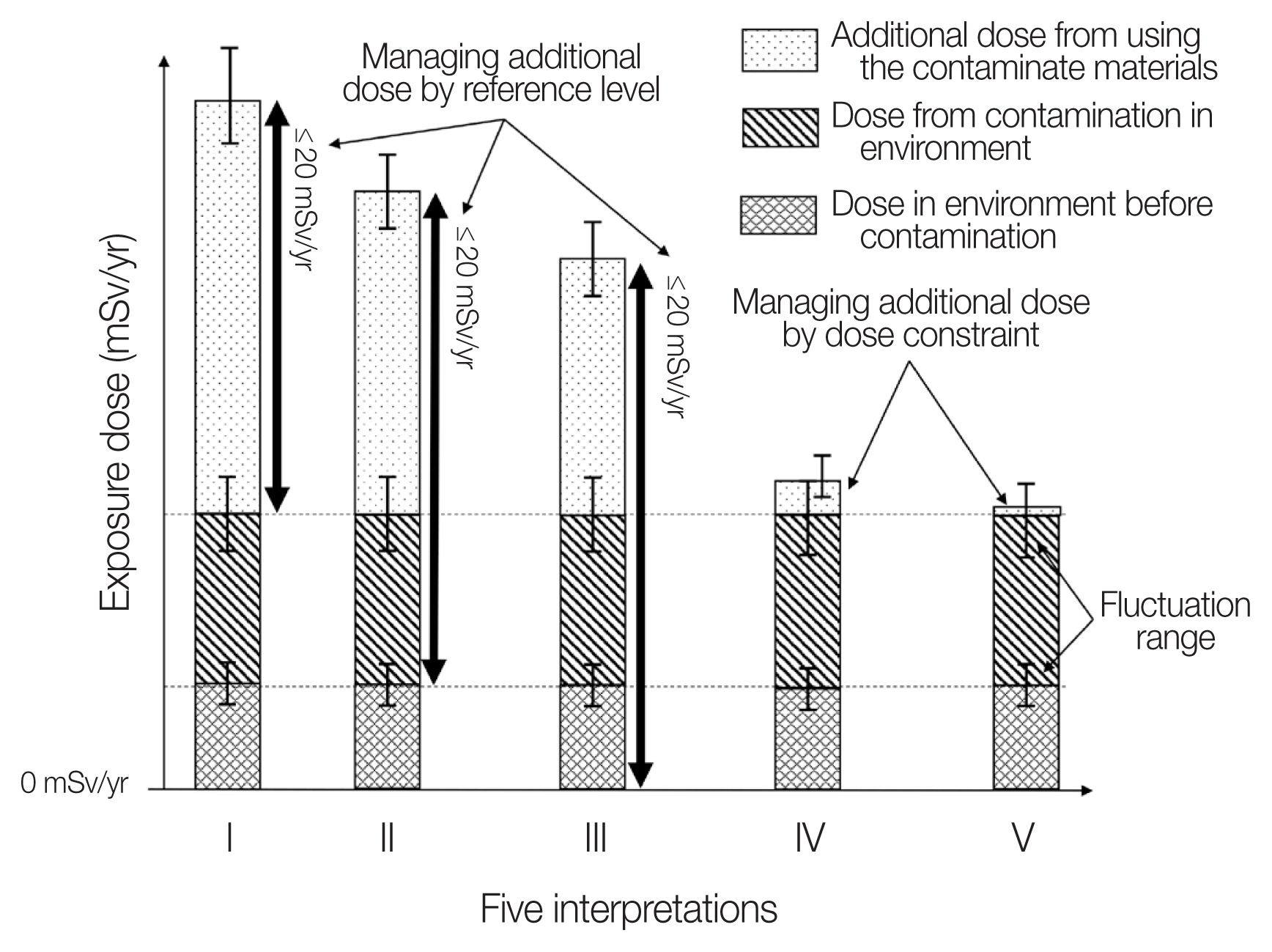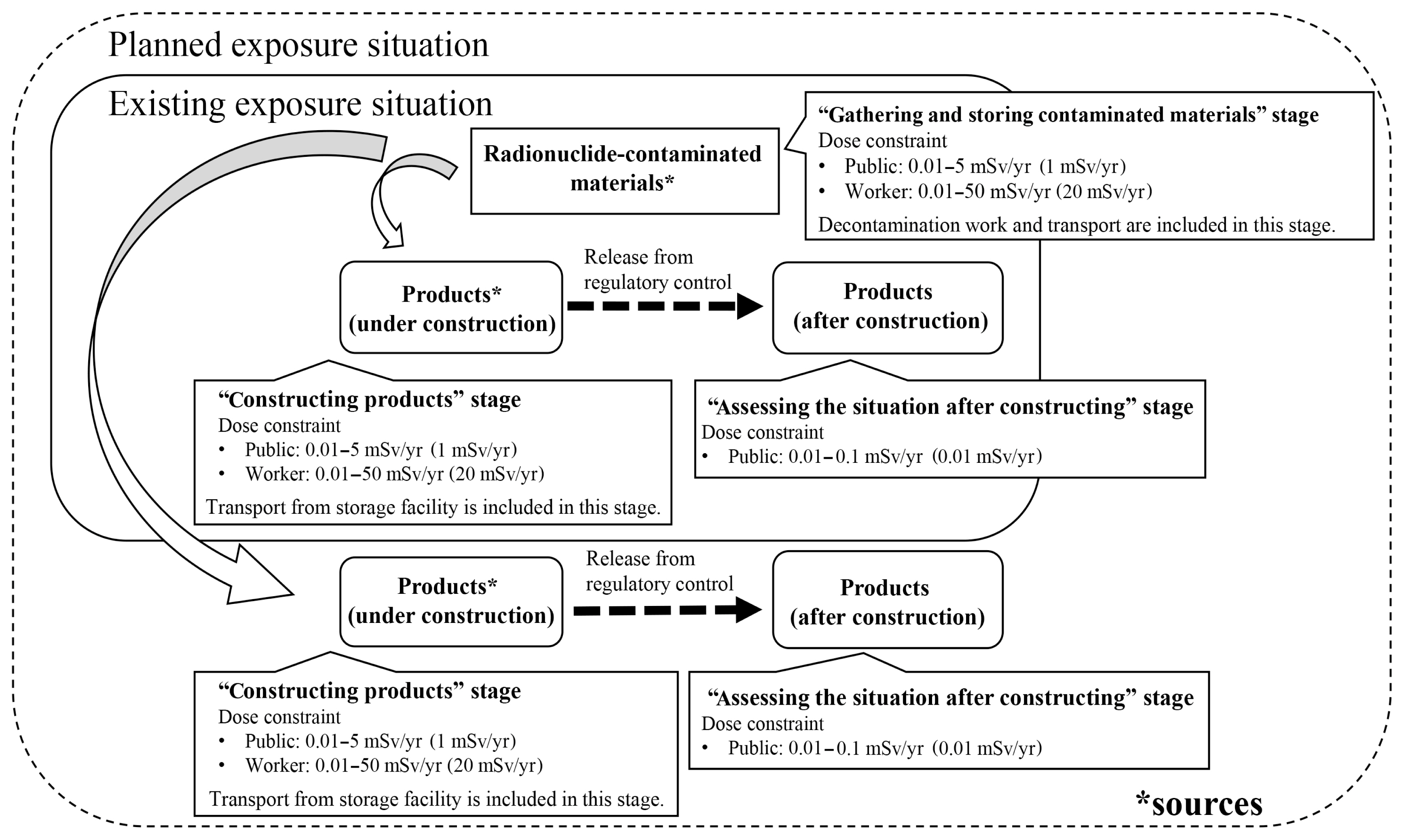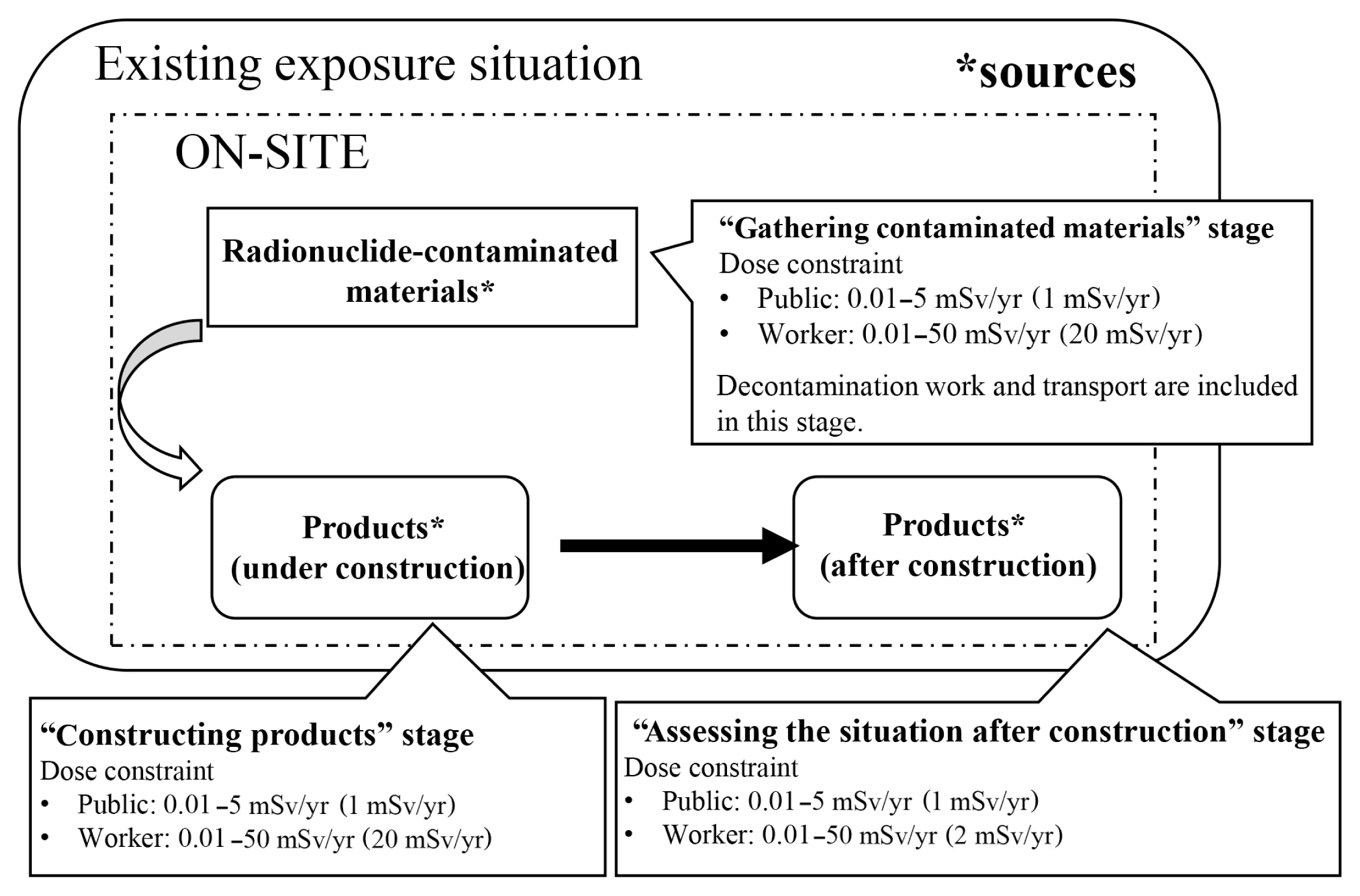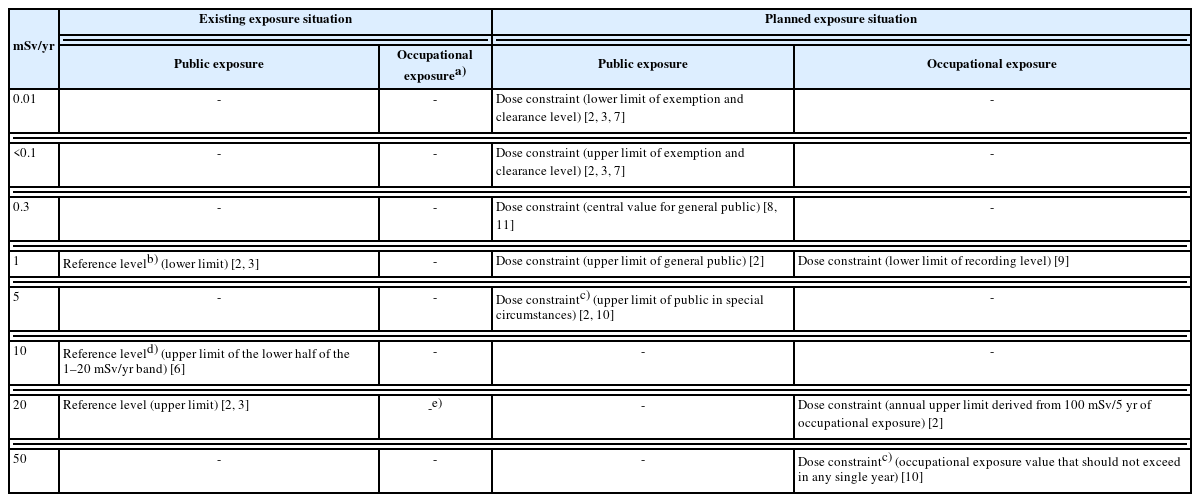A Source-Related Approach for Discussion on Using Radionuclide-Contaminated Materials in Post-accident Rehabilitation
Article information
Abstract
Background
In the process of discussion on the possibility of using radionuclide-contaminated soil and debris generated by radiation disasters, a strategy for the proper management of radiation exposure protection while considering the source of the contaminated materials is necessary.
Materials and Methods
The radiological protection criteria that are likely to be applied to the source-related approach based on the International Commission on Radiological Protection recommendations and the International Atomic Energy Agency safety standards are summarized. We proposed five interpretations of radiation protection to contribute to the promotion of discussion on the possibility of using a part of low-level-radionuclide-contaminated soil and debris in the post-accident rehabilitation. Interpretations I to III are based on the idea of “using a reference level to protect the public in post-accident rehabilitation,” whereas IV and V are based on the idea of “using the dose constraint to protect the public in the post-accident rehabilitation when the sources are handled in a planned activity.” The former idea is subdivided into three based on the definition of the source, which is managed by the reference level, and the latter idea is divided into two depending on whether or not additional dose from using contaminated materials is deemed acceptable.
Results and Discussion
To confirm the applicability of the five interpretations presented, we suggested the concrete values of protection criteria via two feasible cases. In this case study, we proposed radiation protection by the dose constraint based on the Interpretation IV and chose 1 mSv/yr for the public and 20 mSv/yr for workers dealing with radionuclide-contaminated materials.
Conclusion
We concretely and systematically demonstrated how the concept of radiation protection can be applied to the process of discussion on the possibility of using radionuclide-contaminated materials within the framework of an international system of protection. This study’s findings can provide necessary information to discuss the possibility of using radionuclide-contaminated materials as an alternative option for recovery and reconstruction after a radiation disaster from the viewpoint of radiation protection.
Introduction
The Fukushima Daiichi Nuclear Power Station (1F) accident in March 2011, released radionuclides into the environment. Since then, large amounts of soil and debris contaminated by radionuclides have been generated inside and outside of Fukushima Prefecture. Considering the final disposal site, disposing such massive amounts of radionuclide-contaminated soil and debris as radioactive wastes by simply applying the current radiation protection framework is not a feasible option. As an alternative, reusing part of low-level-radionuclide-contaminated materials could be an effective way to reduce the total amounts of soil and debris requiring final disposal [1].
In the process of discussion on the possibility using radionuclide-contaminated soil and debris generated by radiation disasters, a strategy for the proper management of radiation exposure protection while considering the source of the contaminated materials is necessary. When the radionuclide-contaminated soil and debris are used, they are treated as radiation sources that already exist in the environment. This implies that there is a strong incentive to apply the framework of radiation protection in existing exposure situation for the process of using them. According to the 2007 Recommendation of the International Commission on Radiological Protection (ICRP 2007) [2], the reference level of 1–20 mSv/yr is applied as a radiation protection measure under existing exposure situations. The reference levels for the exposure of workplaces under such situations, such as exposure due to radon in workplaces, exposure to cosmic radiation, and exposure arising from remedial action in areas with contaminations by residual radioactive material, have been suggested in the International Atomic Energy Agency (IAEA) 2014 [3], IAEA 2018 [4], ICRP 2016 [5] and ICRP 2020 [6] standards. However, to date, no specific guidance exists for applying reference level to reusing radionuclide-contaminated materials in existing exposure situations. After the 1F accident, Ministry of the Environment of Japan announced a guideline of radiation protection for using removed soil generated by decontamination, which suggests additional dose for workers and the public should not exceed 1 mSv/yr in the construction stage and 0.01 mSv/yr after the construction stage [1]. This guideline is applicable to radiation protection for using contaminated materials in general situation, although it does not show clear explanation for application of reference level and dose constraint based on exposure situation. Setting the reference level flexibly by each country considering their specific situations and the international radiation protection rules is important.
Therefore, we propose five interpretations of public protection against radiation to contribute to the promotion of discussion on the possibility of using a part of low-level-radionuclide-contaminated soil and debris in the post-accident rehabilitation. In this study, the applicability of the five interpretations of radiation protection is examined while assuming the feasible cases.
Materials and Methods
1. Radiological Protection Criteria in Previous Reports
The radiological protection criteria that are likely to be applied to the source-related approach based on ICRP recommendations [2, 6–10] and IAEA safety standards [3, 11] are summarized in Table 1. ICRP 2007 [2] emphasizes the primary importance of source-related assessments so that actions can be taken to ensure the protection of individuals from contaminated sources.
Further, the five interpretations of radiation protection for using radionuclide-contaminated soil and debris under existing exposure situations are proposed based on the ICRP recommendations and IAEA safety standards. These five interpretations are a variety of approaches that can be chosen in the management of the additional dose from contaminated materials based on the current radiation protection rule. To confirm the applicability of the five interpretations, we discuss the concrete values of different protection criteria for use in the process of removing soil generated by decontamination activities in Fukushima as well as the restricted use of contaminated rubble on the 1F site.
2. Applying the Recommendations and Safety Standards Regarding Radiation Protection during Use of Radionuclide-Contaminated Materials
Fig. 1 shows an image of the five interpretations of public protection against radiation. In general, additional dose in post-accident rehabilitation means all exposure generated by accident, while we divide exposure generated by accident into “additional dose from using the contaminated materials” and “dose from contamination in the environment,” in order to consider the diversity of source-related management for the various possible sources. Since the target of this study is reusing contaminated materials in post-accident rehabilitation, we consider the possibility that the additional dose from using contaminated materials will be larger than the dose from the environment. The explanations for each interpretation are described below.

Five interpretations of public radiation protection in reconstruction stage after radiation disaster.
I. Applying the reference level (up to 20 mSv/yr) only to the additional dose due to the reuse of contaminated materials
This interpretation suggests that the reference level for additional dose from using contaminated materials can be set up to 20 mSv/yr, which is the upper limit of the reference level under the existing exposure situation. The management of radiation protection in using radionuclide-contaminated materials could be difficult when these are used in not only existing exposure situations but also under planned exposure situations owing to the differences in radiation protection concept (common with II and III). Moreover, it may be difficult to achieve public understanding for the use based on this interpretation because of the large additional dose required (common with II and III). Given that the reference level is the residual dose, this interpretation, which can be set to 20 mSv/yr for using materials in contaminated environments, may not be considered as an appropriate reference level.
II. Applying the reference level (up to 20 mSv/yr) to all the doses originating from a nuclear incident
This interpretation suggests that the dose for the source generated under an emergency exposure situation is defined as the additional dose, and the reference level can be set up to 20 mSv/yr for the total value of the additional dose.
III. Managing the additional doses from the contaminated materials to ensure that the total additional dose in the target environment after using is under 20 mSv/yr
This interpretation suggests that the reference level for the total dose in the environment can be set up to 20 mSv/yr.
IV. Implementing the source-related protection based on the planned exposure situation for the planned use regardless of the exposure situation at the site (applying the concepts of the dose constraint)
This interpretation suggests that all exposure doses from planned work can be managed by the dose constraint regardless of the exposure situation (common with V). Fig. 2 shows an image of radiation protection based on planned exposure by using contaminated material in existing exposure situation. A detailed explanation of Fig. 2 is described in the Result and Discussion section. Moreover, a significant feature of this interpretation is the treatment of all activities requiring radiation protection related to recycling as planned exposure, along with the application of a unified management idea in all exposure situations. This is consistent with the idea of occupational exposure in existing exposure situations in ICRP 2007 [2] and IAEA 2014 [3] standards. However, there may be an opinion that an approach of radiation protection by only this idea does not fully utilize the idea of existing exposure situation. The idea of existing exposure situation has been newly introduced by ICRP 2007 [2] for high-level natural exposure as well as recovery and reconstruction after the accident. In Table 2, we propose a set of protection criteria for the source-related management in using contaminated materials under radiation protection management. These protection criteria are selected based on Table 1. There is a possibility that 1 mSv/yr is a suitable value for radiation protection in planned activity in post-rehabilitation by the fact that the upper limit of dose constraint for public in planned exposure situation strategically coincides with the lower limit of reference level for public in existing exposure situation.

Range of protection criteria in using contaminated material (soil) off-site. Values described in parentheses are the chosen values in this case study.
V. Not allowing additional doses caused by the use in principle (applying the clearance level)
This interpretation suggests that using the contaminated materials should be operated with sufficiently small additional doses that do not require radiation protection. The main feature of this idea is that it does not add significant exposure doses by the use, making it easier to obtain public understanding. However, it may be too overprotective in post-accident rehabilitation (In applying the clearance level, the same value is set with the clearance level used in Japan for optimizing protection. Note that the clearance level is not used as the dose constraint value for implementing clearance).
In using contaminated materials, radiation protection for the public should be managed by any specific radiation protection interpretation selected from I to V, which is selected based on the extent of contamination. The extent of contamination is expressed by the area of the contaminated environment and the dose level received from the contamination. However, the features of radiation protection are different from I to V, and the degree of social acceptance varies accordingly; thus, no single answer can be considered optimal in any situation.
In this paper, we select one radiation protection interpretation from I to V based on whether the extent of contamination is large enough to change the existing radiation protection management for the public prior to any radiation disaster. Given that radiation protection for the public in normal situations is managed based on the concept of planned exposure, we propose that the additional dose of 1 mSv/yr by radiation disaster could be used as a criterion to select one radiation protection interpretation from I to V. We set 1 mSv/yr as the lower limit of the reference level of the existing exposure situation. Moreover, we would like to emphasize the fact that 1 mSv/yr was once used as the intervention exemption level in ICRP 1999 [12].
Results and Discussion
1. Application of the Recommendations and Safety Standards to Case Studies
In this paper, two feasible cases are selected to examine the application of the recommendations and safety standards: using removed soil generated by decontamination off-site and using contaminated debris on-site. Contaminated soil and debris may be used as materials for civil engineering projects, such as road materials, construction base, and landfill materials. In this study, it is assumed that such use is planned in an environment whose contamination has the same extent as that of Japan after the 1F accident.
After the 1F accident, a total of 104 municipalities in eight prefectures are known to have over 1 mSv/yr annual effective dose as an additional dose calculated by the simplified measurement (dose equivalent) value [13]. However, this is not a clearly described dose level corresponding to the existing exposure situation recommended by ICRP. When 1 mSv/yr is assumed to be the lower limit of the existing exposure situation, eight prefectures have been identified to have municipalities corresponding to the existing exposure situation. This is approximately 5% of the total number of municipalities in Japan. Considering population density, the population in these municipalities makes up less than 5% of the country’s total. Given that interpretations I to III are the radiation protection concepts based on the reference level, if these are selected for radiation protection, the use of contaminated material can be conducted only under existing exposure situations. When interpretations I to III are selected for an environment after 1F accident with less than 5% people, there is a possibility that inequities in the distribution of individual exposure occur. ICRP 2018 [14] suggests that “radiation protection criteria aim to reduce inequities in the distribution of individual exposures in situations where some individuals could be subject to much more exposure than others” in paragraph 54. Thus, to reduce such inequities, we recommend that interpretations IV and V should be selected for radiation protection in Japan after the 1F accident.
Meanwhile, in selecting interpretations IV or V, we compare the social benefits from using contaminated materials based on both concepts. One of the large benefits for a society is reducing the costs of recovery and reconstruction from radiation disasters (e.g., reducing human resources required for burial disposal and the costs of materials for recovery and reconstruction). We assess whether the interpretation IV is more suitable for making the social benefit larger than the interpretation V. Moreover, the validity of radiation protection based on the interpretation V in post-accident rehabilitation is not adequately explainable in the context of the radiation protection framework that is based on an international agreement. This is because such radiation protection handles extremely low-level materials that are smaller by 1 to 2 orders than the natural background radiation level and have already existed before the radiation accident.
In the current study, a chosen interpretation from I to V is applied uniformly throughout the country while considering the historical and cultural background of radiation protection in Japan, which is based on a single legal system. In considering the geographical conditions and cultural backgrounds of radiation protection in a specific target area, it is important to determine the administrative unit (e.g., nation, state, and prefecture) that uniformly applies one interpretation for radiation protection.
2. Case Study for Using Contaminated Materials Off-Site
Fig. 2 shows the range of protection criteria in each stage in using contaminated materials based on Table 2. The stages are as follows: (Stage 1 “gathering and storing contaminated soil and debris,” Stage 2 “constructing products,” and Stage 3 “assessing the situation after construction”). We set two exposure situations in the environment with contamination distribution on the assumption that the exposure situation is determined by air dose rate in the environment.
For the protection criteria meant for the workers who engage in radiation work, 20 mSv/yr is chosen in Stages 1 and 2. From Table 2, it can be observed that 1, 20, and 50 mSv/yr are the available values for dose constraints meant for the workers. If 1 mSv/yr is chosen, the workers can only perform these works with 1 mSv/yr additional dose although the dose limit is 20 mSv/yr. This approach is inconsistent with the previous management of radiation protection. Meanwhile, 50 mSv/yr may not be appropriate for the dose constraint of workers considering the existing exposure situation that has shifted from emergency exposure by lowering the reference level with time. In this study, we chose 20 mSv/yr for the upper limit of dose constraint of the workers; nevertheless, in the actual management of radiation protection in various cases, it is possible to choose less than 20 mSv/yr for the optimization process.
For the public protection criteria, 1 mSv/yr is chosen in Stages 1 and 2. From Table 2, it can be observed that 0.01, <0.1, 0.3, 1, and 5 mSv/yr are the available values for the public dose constraint. Here, 5 mSv/yr is derived from ICRP 1991 [10] (i.e., “in special circumstances, a higher value of effective dose could be allowed in a single year, provided that the average over 5 years does not exceed 1 mSv per year”). Furthermore, 5 mSv/yr is not available for public dose constraint when these stages continue for over a year. In the range of 0.02–1 mSv/yr, we judge the upper value to be suitable for public dose constraint based on the interpretation IV considering the limited period of these stages. A local review as to whether adequate protection is conducted is confirmed by a method suggested hereinafter.
In Stage 3, the products must be cleared from the regulatory control in the long-term after confirming that the dose from the products is sufficiently small. This case study is essentially different from clearance in that the products are used in a specific location. In addition, the concept of the clearance level is not applied in special measure laws on dealing with environmental contamination with radioactive materials generated in the 1F accident [1]. Nevertheless, considering the environmental pollution levels in Japan and the applicability and feasibility at the site after the 1F accident, we propose the application of a dose constraint value of 10 μSv/yr, which corresponds to the clearance level adopted by Japan.
All the protection criteria for using contaminated materials off-site based on the interpretation IV are corresponding to the guideline for the radiation protection for using removed soil generated by decontamination which is suggested by the Ministry of the Environment of Japan [1].
3. Case Study for Using Contaminated Materials On-Site
Fig. 3 shows the range of protection criteria in each stage in using contaminated materials based on Table 2. We assumed that a site in which using contaminated materials is planned, is under an existing exposure situation and that the exposure of on-site workers is controlled. The targets of occupational exposure protection are the workers operating within a controlled area, and the targets of public exposure protection are those who work outside a controlled area, along with visitors and the general public near the site boundary.

Range of protection criteria in using contaminated material (debris) on-site. Values described in square brackets are the chosen values in this case study.
Following the same process for the off-site management, a protection criterion of 20 mSv/yr is set for workers in Stages 1 and 2, and that of 1 mSv/yr is set for the public in all stages. The protection criterion for workers in Stage 3 is set as 2 mSv/yr based on a new approach proposed by Shimada et al. [15]. This is because the protection criteria for occupational exposure to the use of the contaminated materials generated by radiation disaster in existing exposure situations are not clearly described in the ICRP recommendations. In consideration of the radiation protection for workers engaged in tasks other than using contaminated materials (e.g., decommissioning) after constructing products, it is not reasonable for radiation protection management to restrict their work time excessively to reduce additional exposure from such products. Thus, we propose a policy to set the protection criteria in a way that does not significantly increase the dose rate from additional doses in the work place. In other words, we agree with the approach of Shimada et al. [15], and apply 2 mSv/yr (it is 10% of the limit of 20 mSv/yr) as the dose constraint of products made by the contaminated materials. We assume that 10% will not occupy a large part of the total dose limit.
4. Method of a Local Review for Public Protection in Post-accident Rehabilitation
In reconstruction stage, in which the background radiation varies greatly, it is difficult to strictly separate the additional dose by using the contaminated materials from the background radiation in the low-dose region. Here, background radiation refers to the air dose rate in the current exposure situation after a radiation disaster. Therefore, we propose implementing radiation protection focused on the total amount of exposure dose for the public in post-accident rehabilitation. Residents living off-site and workers outside controlled area may be included as a target group for this proposal. In Stage 1 and 2 in Figs. 2 and 3, external exposure and internal exposure should be managed as an additional dose. External exposure is estimated based on the air dose rate by environmental monitoring. Internal exposure is estimated as dust inhalation. To confirm the influence of internal exposure to total exposure, internal exposure by inhalation is estimated previously based on the dust concentration in air. If internal exposure has a large influence, internal exposure should be estimated based on measurement data of dust concentration at the reusing site, or measures to reduce internal exposure are needed. In Stage 3, only external dose is estimated as an additional dose, after confirming that contaminated materials are not used in the surface of products.
Conclusion
In this study, we proposed five interpretations of radiation protection to contribute to the promotion of discussion on the possibility of using a part of low-level-radionuclide-contaminated soil and debris in post-accident rehabilitation. Interpretations I to III are based on the idea of “using a reference level to protect the public in the post-accident rehabilitation,” whereas Interpretations IV and V are based on the idea of “using the dose constraint to protect the public in post-accident rehabilitation when the sources are handled in a planned activity.” The former idea is subdivided into three based on the definition of the source, which is managed by the reference level, and the latter idea is divided into two depending on whether or not an additional dose from using contaminated materials is deemed acceptable. Following the ICRP recommendations and IAEA safety standards, we showed usable protection criteria for source-related management in the process of using contaminated materials that are under radiation protection management. To confirm the applicability of the five interpretations presented, we suggested the concrete values of protection criteria via two feasible cases. In this case study, we proposed radiation protection by dose constraint based on the interpretation IV, and chose 1 mSv/yr for the public and 20 mSv/yr for workers dealing with radionuclide-contaminated materials. Regarding the management of protection criteria, a method involving a local review for public protection in post-accident rehabilitation is then proposed.
Through this study, we concretely and systematically demonstrated how the concept of radiation protection can be applied to the process of discussion on the possibility of using radionuclide-contaminated materials within the framework of an international system of protection. This study’s findings can provide necessary information to discuss the possibility of using radionuclide-contaminated materials as an alternative option for recovery and reconstruction after a radiation disaster from the viewpoint of radiation protection.
Acknowledgements
Fruitful discussions with Dr. Ogino of the Nuclear Regulation Authority in Japan, Dr. Hattori and Dr. Sugiyama of the Central Research Institute of Electric Power Industry, and Mr. Takeda and Mr. Shimada of the Japan Atomic Energy Agency are greatly appreciated.
Notes
Conflict of Interest
No potential conflict of interest relevant to this article was reported.
Ethical Statement
This article does not contain any studies with human participants or animals performed by any of the authors.
Author Contributions
Conceptualization: Miwa K, Iimoto T. Methodology: Miwa K. Writing - original draft: Miwa K. Writing - review and editing: Miwa K, Iimoto T.


